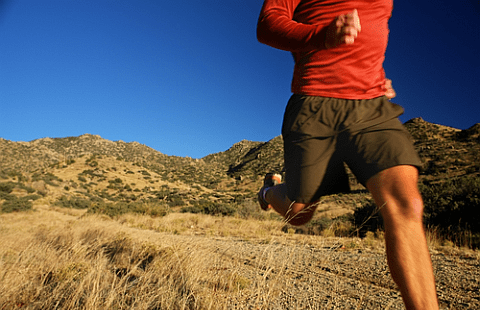Trail Running 101

Running on trails is different from any other type of running. In Singapore (home of Coach Shem Leong), the call of the wild offers us a much needed escape from the din of the grey urban landscape. If the promise of getting a little muddy and filling your lungs with freshly oxygenated rain forest air strikes your sense of adventure then read on, this one’s for you…
The Basics
No matter what level of runner you are, as long as you don’t suffer from chronic ankle, knee or back injuries, there is a trail out there with your name on it just waiting to be discovered.
Beginners should start with ‘easier’ trails of simple packed dirt or grass tracks to get a feel for the softer and less stable ground underfoot. The Green Corridor is a good place to start conditioning your knees and ankles for a bumpier ride. You would also be wise to aim for a conservative distance that you can complete with confidence. To the uninitiated, trail running is tough and a shorter distance can feel like the equivalent of a longer run on the road.
After a couple of goes, don’t be surprised if you’re seeking out the more challenging undulating trails in the rock and root covered terrain of Macritchie Reservoir.
The beauty of running trails is that you’re surrounded by nature so please stick with the programme and let the route dictate the run. Don’t worry about your pace or heart rate or stride rate or beating your previous best time, just let go and enjoy the crunch of gravel underfoot, the glorious sunbeams bursting through the canopy, the splash off a puddle on your calves, the sound of birdsong.
Checking your ‘data’ every 5 seconds takes away from the whole experience of navigating the twists and turns and fallen tree trunks in the road. Without the distractions of ‘keeping to your heart rate training zone’ or ‘sticking to race pace’ you will quickly learn how to dial in your own perceived effort levels as you become acutely more aware of your rate of breathing and how your legs feel moving over the humps and bumps in the road. This is by far the most valuable and underrated (and for some, the most difficult) lesson to grasp for all runners.
Just because you’re running without gadgets, it doesn’t mean you can switch off. Trail running requires more concentration and attention to your stride because you need to decide where every single foot-strike is going to land in order to avoid a twisted ankle or worse. Make it a habit to stay alert every single step of the way – literally. Scan the ground ahead of you by casting your gaze about 15 – 20 meters ahead and track your eyes backwards ( towards your feet) left to right continuously across your line of vision and look out for exactly where you are going to plant your next step.
Training for the trails.
You don’t need to be a super runner to enjoy the trails but the fitter and stronger you are, the more you will be able to enjoy the challenges of going off piste. Any form of structured training that makes you a better runner, will carry over to making you a better off roader too. For example, a 20 min programme of lunge and squat variations to build strength in yours quads and glutes performed twice a week will reap benefits across the board. However, there are some subtle differences between trail and road running that are worth mentioning and some specific tips to help you along:
1) Dodging roots and potholes, rocks and muddy puddles requires quick and reflexive lateral (side to side) micro adjustments to your standard pavement / treadmill running style. Multi-directional single leg hops are a great drill that will develop your ability to change directions quickly. They also strengthen the smaller supporting stabilizing muscles and connective tissue around the ankle and knee joint which can take a beating when running on the rougher stuff. Start by hopping on one leg backwards and forwards for 20 – 30 seconds at a time, Then progress to hopping in a “T” shape and finally hop on one leg in a square around a cone. Reverse directions and alternate legs.
2) Overcoming the little climbs on our local Singapore trails become easier if you’re able to put in some form of uphill running in the week. These are some of my favourite ways to throw some hills into the mix;
a. Short hard hill sprint repeats can be done after an easy 30 – 60 min run. Simply charge up a steep slope as hard as you can for 30 – 40 seconds and repeat 4 – 8 times.
b. Longer sustained uphill runs at moderate intensity can be done at Mt Faber/ Kent Ridge Park/ Rifle Range Road loops. Just plug into a steady moderate pace on the flat ground and work to maintain that pace all the way up the slope. Recover at an easier pace while descending.
3) Endurance junkies training for off- road ultra-marathons should do their long runs over 2 days back to back on consecutive days. This allows you an overnight recovery while still retaining the required mileage high. It reduces the risk of injury and leaves you fresher after the long run so that you are able to train more consistently.
4) Finally, there’s no better way to improve your trail running skills than to actually run on them. Experiment with using the trails creatively to mix the intensity of the runs. For example:
a. Measure out a 1 or 2km strip of trail and use this as an interval loop. For example 4 x 2km with 4 min recovery after each one. This translates to a solid 8km run. Using the same stretch, you could also finish a long easy 10km run with a hard 2 x 2 km at the end. This teaches your body how to start conservative in order to finish strong.
b. Instead of simply cruising your usual weekend long trail run you could run the second half as 1 min hard, 1 min easy to build strength.
5) Running in the trials in the rain is tremendous fun but if it is absolutely pouring and lightning is flashing across the sky (and landing close by) then it’s safer to head to the gym and get your running fix instead. Here how you can train specifically for the trails while indoors;
a. Do a random hills running set on the treadmill by using the ‘incline’ function instead of the ‘speed’ button. After a 20 min warm up try to complete the following sequence at the fastest pace that you can hold without changing the speed for the entire run. Advanced runnerS can aim for 2 rounds!
5 mins @ 0% gradient
1 min @ 8% gradient
5 mins @ 0% gradient
2 mins @ 6% gradient
5 mins @ 0% gradient
3 mins @ 4% gradient
b. Work on your core and functional strength with the help of Swiss Balls, TRX and Bosu Balls. Here are some exercises that you can try:
i. Single Leg lunges with a TRX
ii. Single/ double leg bridges on the Swiss Ball
iii. TRX planks with jackknifes
iv. Plyometric box jumps
v. Squats on the bosu balls
As more and more runners discover the joys of taking to the trails, the aim of this is article is to give them tips on how to enjoy the trails more fully and also to encourage the ‘roadies’ out there to head for the woods.
Trail Etiquette for Runners
It is such an awesome feeling to be charging down a trail that you barely notice the trees zipping by. You feel completely in control and utterly invincible. You feel like you own the trail… but hang on… you don’t!
Trails are public recreational spaces to be shared by everyone. Sure, they maybe your secret training spot for that half marathon PB that you are going to smash but remember that it’s also a family day out for the many young families and it’s also a romantic date spot for the teenagers and it’s also a treasure trove of wildlife pictures of for the amateur photographer.
1) Just because you’re going faster than the walkers and hikers doesn’t mean you have the right of way. Don’t charge down other members of the public that are enjoying nature at a slower pace and in a different manner than yourself. If you are overtaking slower moving traffic, slow down and call out “Trail’ or ‘On your right’ in a friendly non threatening manner – no barking out orders.
2) To reciprocate, slower runners/ hikers shouldn’t block the trail by running 2 or 3 abreast especially along the narrow points.
3) Runners be responsible for your bodily fluids. Watch where and how you clear your throat and send your snot rockets. When passing, leave a wide berth so you don’t spray others with your sweat.
4) Don’t spoil the peace and serenity by blasting music from your phones/ other audio devices. If you enjoy music on your runs, earphones are the best option.
5) Don’t litter. This is so obvious that it shouldn’t even be of this list but unfortunately not everyone seems to think so. Take your food wrappers, drink bottles and gel packs with you.
6) Don’t feed the animals because this will draw them out of their natural habitat and upset the food chain and the rainforest ecosystem. They will eventually get reliant on humans for food and lose the ability to fend for themselves.
In conclusion, be patient and share the trail with everyone else enjoying it and take responsibility to leave it as you found it.
Enjoy your running everyone!
Shem Leong
ironguides Coach, Singapore









